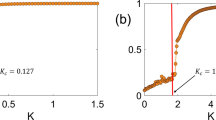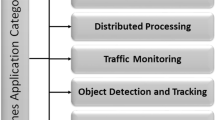Abstract
This paper presents a potential-function-based formation shape control scheme for swarm simulation. The potential function is designed to avoid collision among agents, approach a destination, and achieve a certain shape formation around the destination. The agents move in a swarm to the formation position, which is generated from a reference point and the neighboring agents. In the framework, a local minimum case created by combining the potential repulsed from neighboring robots and that attracted from a reference point is presented; herein, a robot escapes from a local minimum using a virtual escape point after recognizing the trapped situation. Similarly, in the proposed framework, for a well-equipped formation shape, potential functions are designed to maintain the same relative distance between neighboring robots on a formation line, which also satisfies scalability for the number of agents. The simulation results show that the proposed approach can effectively construct elliptical, diamond, and heart-shaped formations for swarm agents.
Similar content being viewed by others
References
D. H. Kim, “A swarm system design based on coupled nonlinear oscillators for cooperative behavior,” International Journal of Control, Automation and Systems, vol. 1, no. 3, pp. 289–295, September 2003.
C. R. Carignan and D. L. Akin, “Autonomous formation flight,” IEEE Control System Magazine, vol. 20, no. 6, pp. 34–44, 2000.
D. J. Stilwell and B. E. Bishop, “Platoons of underwater vehicles,” IEEE Control System Magazine, vol. 20, no. 6, pp. 45–52, 2000.
K. Jin, P. Liang, and G. Beni, “Stability of synchronized distributed control of discrete swarm structures,” Proc. of IEEE Int. Conf. on Robotics and Automation, pp. 1033–1038, 1994.
D. H. Kim, “Flexible and scalable formation for swarm systems,” International Journal of Fuzzy Logic and Intelligent Systems, vol. 5, no. 3, pp. 222–229, September 2005.
Y. Dai and S. G. Lee, “The leader-follower formation control of nonholonomic mobile robots,” International Journal of Control, Automation and Systems, vol. 10, no. 2, pp. 350–361, 2012.
R. Gross, M. Bonani, F. Mondada, and M. Dorigo, “Autonomous self-assembly in swarm-bots,” IEEE Trans. on Robotics, vol. 22, no. 6, pp. 1115–1130, 2006.
T. Arai, E. Pagello, and L. E. Parker, “Editorial: advances in multi-robot systems,” IEEE Trans. on Robotics and Automation, vol. 18, no. 5, pp. 655–661, 2002.
S. P. Hou, C. C. Cheah, and J. J. E. Slotine, “Dynamic region following formation control for a swarm of robots,” Proc. of IEEE International Conference on Robotics and Automation, pp. 1929–1934, 2009.
J. Yaochu, M. Yan, and G. Hongliang, “A morphogenetic self-organization algorithm for swarm robotic systems using relative position information,” Proc. of UK Workshop on Computational Intelligence, pp. 1–6, 2010.
L. E. Barnes, M. A. Fields, and K. P. Valavanis, “Swarm formation control utilizing elliptical surfaces and limiting functions,” IEEE Trans. on Systems, Man, and Cybernetics, Part B: Cybernetics, vol. 39, no. 6, pp. 1434–1445, 2009.
H. Jung and D. H. Kim, “Formation algorithm with local minimum escape for unicycle robots,” Journal of Control, Robotics, and Systems, vol. 19, no. 4, pp. 349–356, 2013.
C. Pinciroli, M. Birattari, M. Dorigo, M. del Rey Zapatero, T. Vinko, and D. Izzo, “Self-organizing and scalable shape formation for a swarm of pico satellites,” Proc. of Conference on Adaptive Hardware and Systems, pp. 57–61, 2008.
S. S. Ge, C. H. Fua, and W. M. Liew, “Swarm formations using the general formation potential function,” Proc. of IEEE Conference on Robotics, Automation and Mechatronics, vol. 2, pp. 655–660, 2004.
H. Jung, Y. Kim, and D. H. Kim, “Visual cooperation based on LOS for self-organization of swarm robots,” International Journal of Control, Automation and Systems, vol. 11, no. 1, pp. 216–224, 2013.
X. Yan, J. Chen, and D. Sun, “Multilevel based topology design and formation control of robot swarms,” Proc. of IEEE International Conference on Robotics and Biomimetics, pp. 174–179, December 2011.
S. H. Kim, G. Lee, I. Hong, Y. J. Kim, and D. Kim, “New potential functions for multi robot path planning: SWARM or SPREAD,” Proc. of the 2nd International Conference on Computer and Automation Engineering, vol. 2, pp. 557–561, 2010.
D. H. Kim and S. Shin, “New repulsive potential function with an angle distribution for local path planning,” Advanced Robotics, vol. 20, no. 1, pp. 25–47, January 2006.
Author information
Authors and Affiliations
Corresponding author
Additional information
Recommended by Associate Editor Yingmin Jia under the direction of Editor Hyouk Ryeol Choi.
This work was supported by Kyungnam University Research Fund, 2013.
Hahmin Jung received his B.S. and M.S. degrees from the Division of Electrical and Electronic Engineering and the Department of Advanced Engineering, Kyungnam University, Korea, in 2009 and 2011, respectively. He is currently a Ph.D. candidate in the Department of Advanced Engineering from Kyungnam University. His research interests include swarm robots, localization, and behavior algorithms.
Dong Hun Kim received his B.S., M.S., and Ph.D. degrees from the Department of Electrical Engineering, Hanyang University, Korea, in 1995, 1997, and 2001, respectively. From 2001 to 2003, he was a research associate under several grants in the Department of Electrical and Computer Engineering, Duke University, NC, USA. In 2003, he joined Boston University, MA, USA, as a visiting assistant professor under several grants at the Department of Aerospace and Mechanical Engineering. In 2004, he was engaged in post-doctoral research at the School of Information Science and Technology, the University of Tokyo, Japan. Since 2005, he has been an associate professor at the Department of Electrical Engineering, Kyungnam University, Korea. His research interests include swarm intelligence, self-organization of swarm systems, mobile robot path planning, decentralized control of autonomous vehicles, intelligent control, and adaptive nonlinear control.
Rights and permissions
About this article
Cite this article
Jung, H., Kim, D.H. Potential-function-based shape formation in swarm simulation. Int. J. Control Autom. Syst. 12, 442–449 (2014). https://doi.org/10.1007/s12555-013-0133-6
Received:
Accepted:
Published:
Issue Date:
DOI: https://doi.org/10.1007/s12555-013-0133-6




